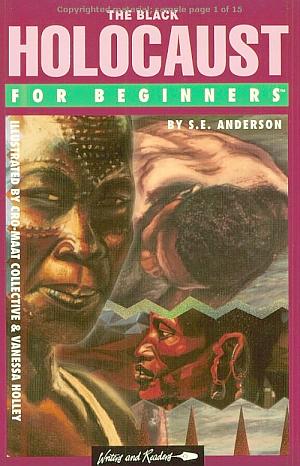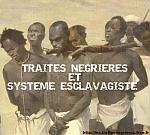Guy Giard
Art Contemporain
|
The Slave Trade
La traite des esclaves
Columbus's First Letter
Transcription of the Basel 1494 Edition
 .......On this island, indeed, and on all the others which I have seen, and of which I have knowledge, the inhabitants of both sexes go always naked, just as they came into the world, except some of the women, who use a covering of a leaf or some foliage, or a cotton cloth, which they make themselves for that purpose.
All these people lack, as I said above, every kind of iron; they are also without weapons, which indeed are unknown; nor are they competent to use them, not on account of deformity of body, for they are well formed, but because they are timid and full of fear. They carry for weapons, however, reeds baked in the sun, on the lower ends of which they fasten some shafts of dried wood rubbed down to a point; and indeed they do not venture to use these always; for it frequently happened when I sent two or three of my men to some of the villages, that they might speak with the natives, a compact troop of the Indians would march out, and as soon as they saw our men approaching, they would quickly take flight, children being pushed aside by their fathers, and fathers by their children. And this was not because any hurt or injury had been inflicted on any one of them, for to every one whom I visited and with whom I was able to converse, I distributed whatever I had, cloth and many other things, no return being made to me; but they are by nature fearful and timid.
Yet when they perceive that they are safe, putting aside all fear, they are of simple manners and trustworthy, and very liberal with everything they have, refusing no one who asks for anything they may possess, and even themselves inviting us to ask for things. They show greater love for all others than for themselves; they give valuable things for trifles, being satisfied even with a very small return, or with nothing; however, I forbade that things so small and of no value should be given to them, such as pieces of plates, dishes, and glass, likewise keys and shoelace tips although if they were to obtain these, it seemed to them like getting the most beautiful jewels in the world. It happened, indeed, that a certain sailor obtained in exchange for a shoelace tips as much worth of gold as would equal three golden coins; and likewise other things for articles of very little value, especially for new silver coins, and for some gold coins, to obtain which they gave whatever the seller desired, as for instance an ounce and a half and two ounces of gold, or thirty and forty pounds of cotton, with which they were already acquainted. They also traded cotton and gold for pieces of bows, bottles, jugs and jars, like persons without reason, which I forbade because it was very wrong; and I gave to them many beautiful and pleasing things that I had brought with me, no value being taken in exchange, in order that I might the more easily make them friendly to me, that they might be made worshipers of Christ, and that they might be full of love towards our king, queen, and prince, and the whole Spanish nation; also that they might be zealous to search out and collect, and deliver to us those things of which they had plenty, and which we greatly needed.
These people practice no kind of idolatry; on the contrary they firmly believe that all strength and power, and in fact all good things are in heaven, and that I had come down from thence with these ships and sailors; and in this belief I was received there after they had put aside fear. Nor are they slow or unskilled, but of excellent and acute understanding; and the men who have navigated that sea give an account of everything in an admirable manner; but they never saw people clothed, nor these kind of ships. As soon as I reached that sea, I seized by force several Indians on the first island, in order that they might learn from us, and in like manner tell us about those things in these lands of which they themselves had knowledge; and the plan succeeded, for in a short time we understood them and they us, sometimes by gestures and signs, sometimes by words; and it was a great advantage to us. They are coming with me now, yet always believing that I descended from heaven, although they have been living with us for a long time, and are living with us to-day. And these men were the first who announced it wherever we landed, continually proclaiming to the others in a loud voice, "Come, come, and you will see the celestial people." Whereupon both women and men, both young men and old men, laying aside the fear caused a little before, visited us eagerly, filling the road with a great crowd, some bringing food, and some drink, with great love and extraordinary goodwill.
.....And I commanded a fort to be built where forthwith, which must be completed by this time; in which I left as many men as seemed necessary, with all kinds of arms, and plenty of food for more than a year. Likewise one caravel, and for the construction of others men skilled in this trade and in other professions; and also the extraordinary good will and friendship of the king of this island toward us. For those people are very amiable and kind, to such a degree that the said king gloried in calling me his brother. And if they should change their minds, and should wish to hurt those who remained in the fort, they would not be able, because they lack weapons, they go naked, and are too cowardly. For that reason those who hold the said fort are at least able to resist easily this whole island, without any imminent danger to themselves, so long as they do not transgress the regulations and command which we gave.
In all these islands, as I have understood, each man is content with only one wife, except the princes or kings, who are permitted to have twenty. The women appear to work more than the men. I was not able to find out surely whether they have individual property, for I saw that one man had the duty of distributing to the others, especially refreshments, food, and things of that kind. I found no monstrosities among them, as very many supposed, but men of great reverence, and friendly. Nor are they black like the Ethiopians. They have straight hair, hanging down. They do not remain where the solar rays send out the heat, for the strength of the sun is very great here, because it is distant from the equinoctial line, as it seems, only twenty-six degrees. On the tops of the mountains too the cold is severe, but the Indians, however, moderate it, partly by being accustomed to the place, and partly by the help of very hot victuals, of which they eat frequently and immoderately.
And so I did not see any monstrosity, nor did I have knowledge of them any where, excepting a certain island named Charis, which is the second in passing from Hispana to India. This island is inhabited by a certain people who are considered very warlike by their neighbors. These eat human flesh. The said people have many kinds of row-boats, in which they cross over to all the other Indian islands, and seize and carry away everything that they can. They differ in no way from the others, only that they wear long hair like the women. They use bows and darts made of reeds, with sharpened shafts fastened to the larger end, as we have described. On this account they are considered warlike, wherefore the other Indians are afflicted with continual fear, but I regard them as of no more account than the others. These are the people who visit certain women, who alone inhabit the island of Mateunin, which is the first in passing from Hispana to India. These women, moreover, perform no kind of work of their sex, for they use bows and darts, like those I have described of their husbands; they protect themselves with sheets of copper, of which there is a great abundance among them. They tell of another island greater than the aforesaid Hispana, whose inhabitants are without hair, and which abounds in gold above all the others. I am bringing with me men of this island and of the others that I have seen, who give proof of the things that I have described.
Bartholomé de Las Casas
Las Casas sailed with Christopher Columbus on his fourth voyage, arriving in Santo Domingo in 1502. In 1510 he became the first Spanish friar ordained in the New World and in 1514, horrified by the Conquistadors’ treatment of the Indians, he returned to Spain to take holy orders and determined to devote his life to mission work in the New World. Las Casas wrote, “In order that the Indians may be preserved in life and liberty there are no other means save that Your Majesty should incorporate them as your vassals in your royal crown.” He claims that the Spaniards are killing the Indians to obtain their riches, “against the law of God and the great destruction of Your Majesty’s royal patrimony .… Your Majesty is compelled by divine precept and law to declare them free.”
Perhaps inconsistently, Las Casas goes on to suggest that Negro slaves be imported as laborers instead. This soon happened, and in 1542 the Indians were formally made equal vassals and their enslavement prohibited. In 1544 Las Casas was named Bishop of Chiapas, Mexico, where he is still much revered.
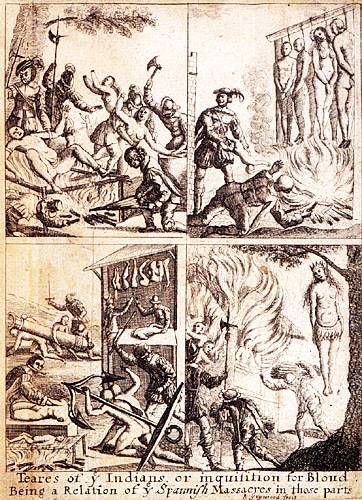 Girolamo Benzoni
Benzoni was born in Milan in 1519 and, as a young man, became fascinated by the New World. From the age of 22, he spent 14 years traveling abroad and in 1556, he wrote a history of the New World that provides a compact history of America from the arrival of Columbus to the conquest of Peru. The Indians attracted his attention and he recorded details of their habits and traditions at a very early date. The accuracy of his observation, depicted in rude woodcut illustrations, give a glimpse of indigenous life before civilization inevitably altered their traditional life ways
He writes:
 "The natives, finding themselves intolerably oppressed and overworked, with no chance of regaining their liberty, with sighs and tears longed for death. Many went into the woods and having killed their children, hanged themselves, saying it was far better to die than to live so miserably serving such ferocious tyrants and villainous thieves... finally, out of two million inhabitants, through suicides and other deaths occasioned by the excessive labour and cruelties imposed by the Spanish, there are not a hundred and fifty now to be found."
Gravure de De Bry: le suicide des Indiens, vers 1560
 To know more about the artist De bry and the context of his engravings
To know more on these subjects
|
Les lieux de provenance des esclaves
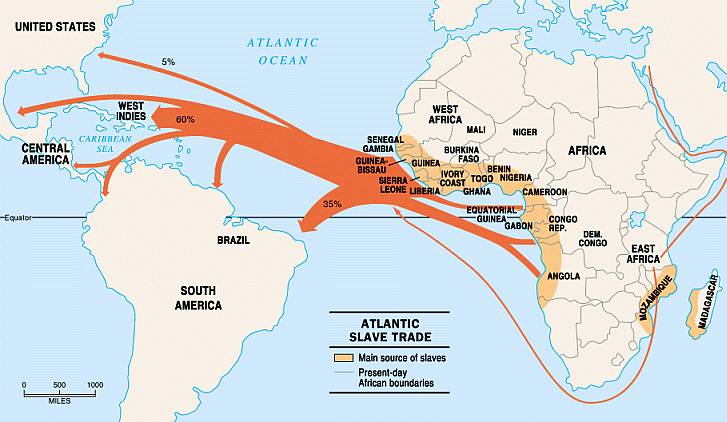 |
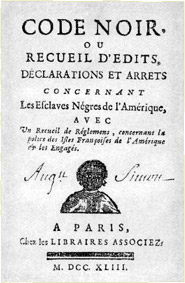 Le Code Noir Le Code Noir Colbert ,mars 1685
Le Code Noir régissait la vie des esclaves dans les habitations.
Il définissait de manière stricte et précise les relations entre les maîtres et leurs esclaves, considérés comme des "biens meubles".
Le Code Noir fixait aussi les conditions d'affranchissement des esclaves.
|
 'Esclaves et Négriers' 'Esclaves et Négriers' Jean Meyer
Découvertes, Gallimard
Au XVIème siècle, le commerce "triangulaire" entre l'Europe, l'Afrique et l'Amérique se met en place. La traite négrière saigne l'Afrique : quinze à vingt millions d'hommes et de femmes déportés en trois siècles vont faire prospérer les plantations des grandes puissances coloniales. Mais la résistance des esclaves à leur condition - révoltes spontanées, insurrections, désertions, marronnage... - et le mouvement abolitionniste, impulsé à la fin du XVIIIème siècle par les Anglais, entament le système esclavagiste.
Jean Meyer retrace le gigantesque trafic et ses enjeux économiques, la féroce exploitation de l'homme noir par l'homme blanc, le difficile combat et la victoire au nom de l'universalité du principe de liberté.
|
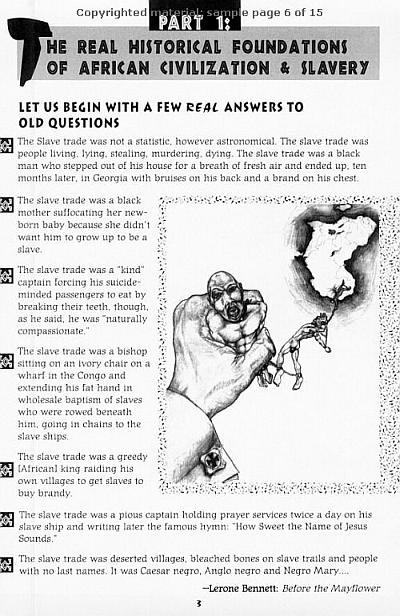  |
Site Internet plus que complet
avec liens et documents historiques
en français et en anglais
Amazing Internet site with links
and historical documents in english and french
A must !!!
|
|
This site aims to help teachers and educators to Break the Silence that continues to surround the story of the enslavement of Africa that began over 500 years ago. It is designed to provide teachers with a variety of resources and ideas about how to teach the subject holistically, accurately and truthfully. It aims to represent the voices that are not usually heard. It hopes to highlight the involvement of Africans in their own liberation and to show that the impact of enslavement of the African continent was so far reaching that the legacies remain with us today, perhaps more powerfully than ever. The Transatlantic Slave Trade, also referred to within this site as enslavement, or the African Holocaust, was not just a part of history that can be forgotten. It forcibly changed the fabric of societies worldwide, economically, politically, socially, culturally and spiritually. Its long lasting legacies are directly relevant to people all over the world today.
How to Use this Site
Breaking the Silence – Learning about the Transatlantic Slave Trade presents the user with a range of information as well as perspectives, from teacher ‘Briefings’ which have been contributed by people from the three regions represented in this site (Africa, Caribbean and Americas and Europe), pages of ‘Links’ to useful websites, easily downloadable ‘Ready to use lesson plans and activities’, a ‘Pick and Mix’ assortment of useful resources that teachers can adapt and use creatively across the curriculum, virtual ‘Slave Routes’ that map out places and people connected to the slave trade or its legacy, in different countries across the three regions and ‘Up from Slavery’, an activity for students or young people that charts a journey through from enslavement to emancipation.
|
|
Site très bien fait, avec un historique
dévellopé sur les Arawaks et les Caraibes,
habitants originaux des Caraibes.
|
Ajouts régulier de nouveaux liens
Vérifier la date de mise-à-jour sur www.guygiard.fr.fm
Regurlarly updated with new links
Check for the date of latest update at www.guygiard.fr.fm
C o u r r i e l :
